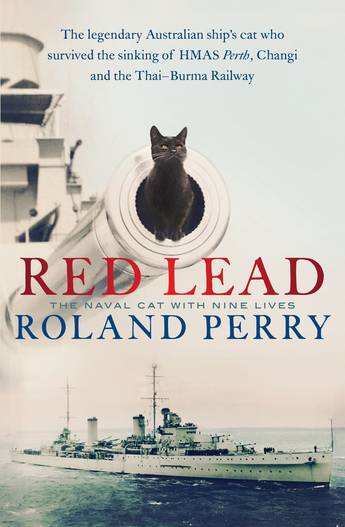
Red Lead – The Naval Cat with Nine Lives. By Roland Perry. Allen and Unwin, Sydney, 2020.
Reviewed by Greg Swinden
Oh Dear.
Well I have read some ‘shockers’ over the years but this book has certainly set a new low standard. It is without a doubt the worst of the ‘pulp history’ that has been trotted out in Australia in the past decade. The author does provide a warning up front stating it is a ‘dramatised narrative’ – the book version of the movie warning of ‘based on a true story’. I should have heeded the warning and not read this book.
Overall I felt I wasted the $30 that I paid for what can be best described as a very poorly written Commando War Comic but without the benefit of pictures (and my apologies to Commando War Comics – many of which have far better story-lines and narrative than this book).
The basic facts are the light cruiser HMAS Perth, was commanded by Captain Hec Waller, RAN, and did fight at the Battle of the Java Sea. The cruiser was later sunk at the Battle of Sunda Strait on the night of 28 February/1 March 1942 in company with the heavy cruiser USS Houston. Those of the ships company not killed did become prisoners of the Japanese. Perth did have a ship’s cat named Redlead (one word), so named as soon after being brought onboard, in late 1941, the kitten knocked over a tin of paint (Redlead) and her paw prints stained the deck. Redlead did try and leave the ship, several times, when alongside at Tanjong Priok following the Java Sea battle but was brought back onboard each time and this was seen by many onboard as a bad omen.
While the basic historical facts are detailed in this book the ‘dramatisation’ soon gets out of control with Red Lead finding a 6 foot wooden skiff (somehow floating in Sunda Strait) and gets ashore. She meets up with Perth survivors who then carry her through various POW camps and finally to the Thai-Burma railway where the cat survives attacks by a cobra, tiger and Japanese soldiers and is finally left with a Thai family and dies of old age in 1965. The ‘hero’ is the fictitious Petty Officer Bolt, who dropped out of Veterinary studies to join the Navy and looks after Redlead while also using his medical skills as a pseudo surgeon on the Thai-Burma railway.
The reality is Redlead, like many of the cruisers crew, did not survive the sinking. Able Seaman Bob Collins who was given the kitten by the daughter of his shipmate, Ray Firminger, did survive the sinking and was quoted in the book Shipmates (Illustrated Tales of the Mascots carried in RAN Ships) that after abandoning ship he sighted the kitten in the water; but she was swept away by the fast flowing current. Several Perth men who returned to Australia in 1945, after three and half years as Prisoners of War, later published books concerning their experiences. None of these books mention Redlead after 1 March 1942 – and except for Ray Parkins Wartime Trilogy none of these books are cited in the bibliography of this dramatisation. Of concern is unsuspecting readers will pick up this book and believe the story and before long the fiction will become fact.
Equally annoying are the many poor descriptions used – such as ‘the ships cable operator handed the captain several cables’ (as opposed to the Yeoman of Signals, or a telegraphist, handing the captain a signal), the constant reference to Red Lead killing rats in the ships kitchen (as opposed to the galley), the ship’s company going to battle stations (vice going to action stations) and why is a Japanese reconnaissance aircraft a ‘spy plane’ and torpedoes ‘silent death missiles’. Damage control is strangely described as – ‘When shells landed he had to hose them down, hopefully after they had exploded’.
History is also re-written with 353 planes from six Japanese battleships attacking Pearl Harbor, Commodore 2nd Class John Collins gets ‘demoted’ to Commander Collins more than once, why does Waller give instructions to Chief Petty Officer Ray Parkin concerning the route they would take (instead of the cruiser’s navigator) and why does one of the Perth survivors keeps calling Petty Officer Bolt ‘Sir’ is beyond me. A good proof-reading by someone with a reasonable knowledge of the Royal Australian Navy and World War II history could have prevented these and many other odd descriptions and factual errors.
There is a reasonable level of knowledge displayed regarding the conditions endured by those who were prisoners of the Japanese. How one USS Houston survivor manages to hang onto his ‘waterproof backpack containing a bottle of bourbon, a torch, a revolver, a mouth organ, some matches and American dollars’ without it being stripped from him by his Japanese captors remains a mystery. Equally while hidden radios did exist in various POW camps throughout Southeast Asia during the war the reference to using torches (battery powered vice flame) on the Thai-Burma railway is an oddity – for men who struggled daily to get enough food in these harsh conditions its seems odd that they could obtain batteries for torches.
Finally in this case you can ‘judge a book by its cover’. The photo on the front cover of a cat sitting in the gun barrel is not Redlead; it’s the ship’s cat of HMS Cornwall taken in 1933. Also the front cover wording stating the “cat who survived the sinking of HMAS Perth, Changi and the Thai-Burma Railway” is false.
Buyers beware and mariners are warned.


